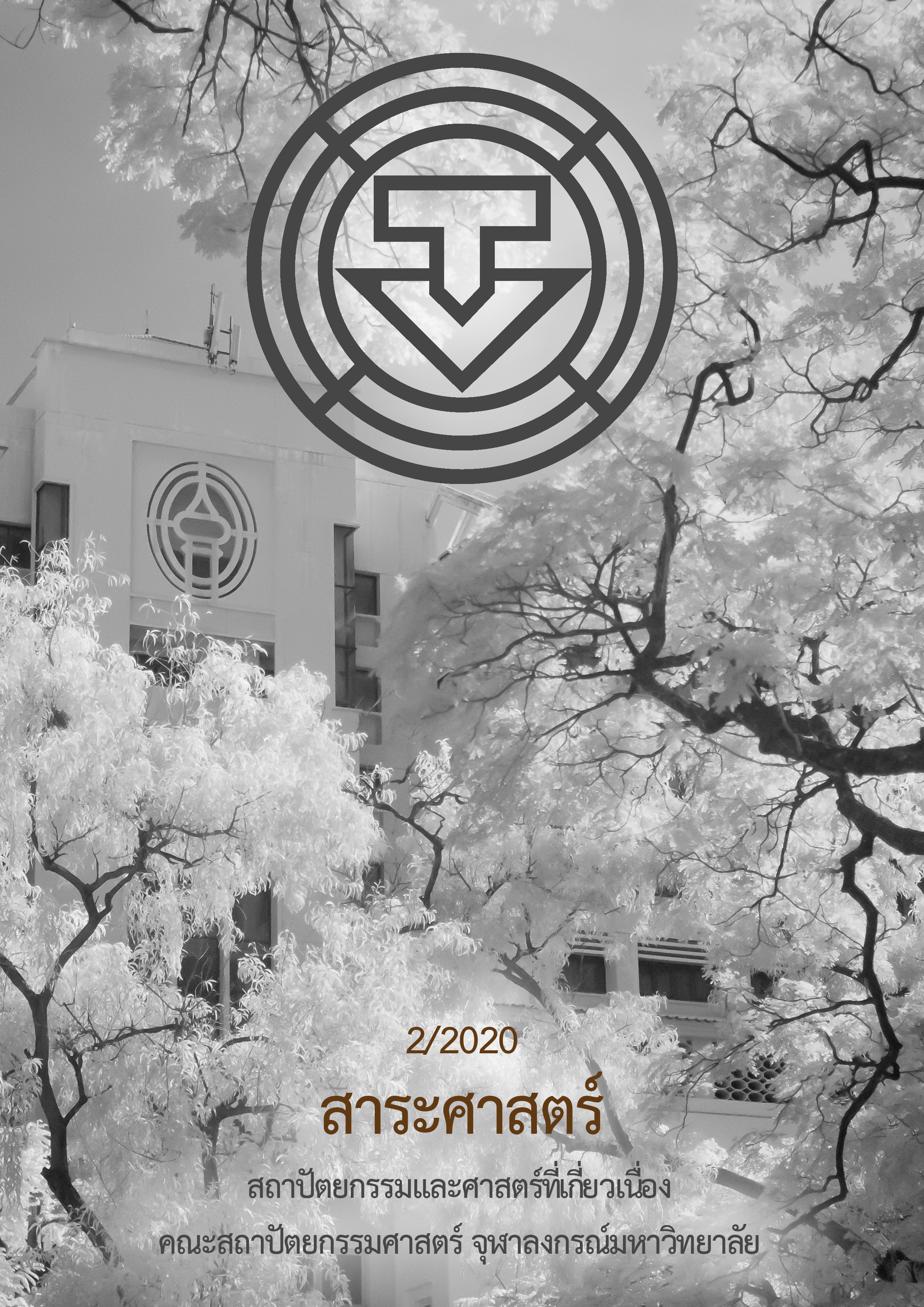องค์ประกอบสถาปัตยกรรมปะตูไซ ในนครหลวงเวียงจันทน์ ส.ป.ป. ลาว
Main Article Content
บทคัดย่อ
บทความนี้ศึกษาเพื่อให้คนรุ่นหลังรับรู้ความตั้งใจของผู้ออกแบบปะตูไซในนครหลวงเวียงจันทน์ (ประตูชัย) มีวัตถุประสงค์เพื่อศึกษาองค์ประกอบสถาปัตยกรรม และหาความหมายของลวดลายการตกแต่งบนปะตูไซจากการสืบค้นเอกสารและลงสำรวจปะตูไซ สามารถจำแนกและหาที่มาขององค์ประกอบสถาปัตยกรรมและจำแนกรายละเอียดของการตกแต่ง จากนั้นนำข้อมูลมาวิเคราะห์การประยุกต์รูปแบบสถาปัตยกรรม ระหว่างลักษณะสถาปัตยกรรมของปะตูไซกับแหล่งที่มา โดยแยกการวิเคราะห์เป็น 3 ส่วนคือ ส่วนฐาน - ตัว ส่วนหัว ส่วนภายใน และทำการวิเคราะห์ความหมายของลวดลายการตกแต่ง ผลสรุปคือ ปะตูไซเป็นการออกแบบอิงจากความเชื่อทางศาสนา ส่วนฐาน - ตัวประยุกต์มาจากสถาปัตยกรรมทั้งสองประตูชัย (ประตูชัยแห่งดวงดาวและประตูชัยติตุส) เจดีย์ศิลปะล้านช้างและซุ้มประตูสิมของวัดใน ส.ป.ป. ลาว ที่สร้างในช่วงศตวรรษที่ 20 ส่วนหัวประยุกต์มาจากบุษบกหรือที่อยู่ของเทพเทวดาตามความเชื่อทางศาสนา ส่วนภายในประยุกต์มาจากสถาปัตยกรรมโรมัน และการวิเคราะห์ลวดลายการตกแต่งสามารถจำแนกได้ 3 รูปแบบคือ ลวดลายการตกแต่งที่สื่อความหมายถึงศาสนาและการปกครองในระบอบกษัตริย์ (ราชอาณาจักรลาว) เป็นการตกแต่งหลัก ลวดลายการตกแต่งที่สื่อความหมายถึงธรรมชาติเป็นการตกแต่งเสริมให้ลวดลายสมบูรณ์สวยงามยิ่งขึ้น
Article Details
เอกสารอ้างอิง
จันทรา ณ ลำพูน. ปทานุกรมศัพท์ สถาปัตยกรรมและช่างก่อสร้าง. พิมพ์ครั้งที่ 15. กรุงเทพฯ: สำนักพิมพ์สมาคมส่งเสริมเทคโนโลยี (ไทย-ญี่ปุ่น), 2545.
ชัยอนันต์ สมุทวณิช. ศัพท์สถาปัตยกรรมศาสตร์ อังกฤษ-ไทย ไทย-อังกฤษ (ฉบับราชบัณฑิตยสถาน). กรุงเทพฯ: อรุณการพิมพ์, 2548.
นริศรานุวัดติวงศ์, สมเด็จพระเจ้าบรมวงศ์เธอ เจ้าฟ้ากรมพระยาและสมเด็จพระเจ้าบรมวงศ์เธอ กรมพระยาดำรงราชานุภาพ. สาส์นสมเด็จ (เล่ม 18). พระนคร: องค์การค้าของคุรุสภา, 2504.
ประภัสสร์ ชูวิเชียร. ๕ มหาเจดีย์สยาม. กรุงเทพฯ: มิวเซี่ยมเพรส, 2554.
พระมหาศิริวัฒน์ สิริวฑุฒโนและประยงศ์ จันทร์แดง. รายงานการวิจัยเรื่อง การศึกษาเชิงวิเคราะห์บทบาทของเทวดาที่ปรากฏในคัมภีร์พระสุตตันตปิฎก. อุบลราชธานี: มหาวิทยาลัยมหาจุฬาลงกรณ์ราชวิทยาลัย วิทยาเขตอุบลราชธานี, 2552.
วีระ อินพันทัง. “คติจักรวาลในเรือนไทย: ร่องรอยที่เลือนหาย.” หน้าจั่ว: วารสารวิชาการคณะสถาปัตยกรรมศาสตร์ มหาวิทยาลัยศิลปากรประจำปีการศึกษา 2551, 23(2551): 63-84.
ศักดิ์ชัย สายสิงห์. เจดีย์ พระพุทธรูป ฮูปแต้ม สิม ศิลปะลายลาวและอีสาน. กรุงเทพฯ: มิวเซี่ยมเพรส, 2555.
สมใจ นิ่มเล็ก. “ฐานอาคารสถาปัตยกรรมไทย.” หน้าจั่ว: วารสารวิชาการคณะสถาปัตยกรรมศาสตร์ มหาวิทยาลัยศิลปากรประจำปีการศึกษา 2544, 18(2544): 17-42.
ບຸນເລີງ ເວີ່ນວິລາວົງ. ສີລະປະລາວ ພາກ I. (ม.ป.ท.): ບໍລິສັດຜະລິດຕະພັນວັດທະນະທຳ, 1979.
ບຸນເລີງ ເວີ່ນວິລາວົງ. ສີລະປະລາວ ພາກ II. (ม.ป.ท.): ບໍລິສັດຜະລິດຕະພັນວັດທະນະທຳ, 1983.
ບຸນເລີງ ເວີ່ນວິລາວົງ. ລວມຜົນງານສີລະປະລາວ. (ม.ป.ท.), 2001.
ປລີດາ ສະຫວັດວົງ. ສີລະປະລາຍລາວບູຮານ ຫລວງພະບາງ. (ม.ป.ท.): ສະຖາບັນຄົ້ນຄວ້າວັນນະຄະດີແຫ່ງຊາດ, 1988.
ປລີດາ ສະຫວັດວົງ. ສີລະປະລາຍລາວບູຮານ ສະຫວັນນະເຂດ. (ม.ป.ท.): ສະຖາບັນຄົ້ນຄວ້າວັນນະຄະດີແຫ່ງຊາດ, 2017.
Forrest, A. The Legacy of the French Revolutionary Wars: The Nation-In-Arms in French Republican Memory. Cambridge: Cambridge University Press, 2009.
Midford, S. “Roman Imperial Triumphal Arches.” Iris: Journal of the Classical Association of Victoria 27(2014): 11- 26.
Palladio, A. The Four Books of Architecture. New York: Dover Publications, 1965.
Pollak, M. Cities at War in Early Modern Europe. Cambridge: Cambridge University Press, 2010.
Sayasithsena, T., Victory Arch. Nong Khai: MTTHAI Press, 1995.
Schmidt, E. A. “The Flavian Triumph and the Arch of Titus: The Jewish God in Flavian Rome.” In Beyond Borders: Selected Proceedings of the 2010 Ancient Borderlands International Graduate Student Conference, D. W. Peninah et al. (Eds.), 1-12. Santa Barbara: Ancient Borderlands Research Focus Group, University of California, 2010.


